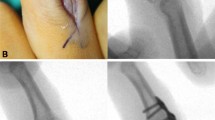Abstract
Background
Middle phalanx physeal fractures in children are rare, and proper treatment gives good results. Despite treatment, these fractures may lead to physeal arrest and growth disturbances leading to severe angulation deformities. Closed wedge osteotomy with internal fixation efficiently corrects the angulation deformities in children.
Methods
We did a retrospective study analyzing 11 children with middle phalanx physeal injuries and severe angulation. Closed wedge osteotomy and internal fixation with plate and screw were done. We interpreted the pre- and postoperative correction of angles, middle phalanx length discrepancy, technical aspects, range of movement, grip strength, pain, and functional outcomes.
Results
The mean age of the patients was 10.5 years. The mean follow-up was 28 months (range 24–30 months). Ten of the 11 patients achieved good radiological union, range of motion, and good outcome. None of the patients had growth plate deformity in the follow-up. All patients had a significant correction of angulation/deformity, length, and improvement of grip strength in the postoperative period (p < 0.05). None had physeal disturbances/abnormalities in the follow-up.
Conclusions
Though middle phalanx physeal fractures are rare and innocuous, adequate treatment is essential to prevent angulation and growth disturbances. Close wedge corrective osteotomy and internal fixation with plates and screws provide stable and rigid fixation. Greater attention is needed to follow-up them until skeletal maturity.
Level of evidence
IV.







Similar content being viewed by others
References
Barton NJ. Fractures of the phalanges of the hand in children. Hand. 1979;11:134–43.
Hastings H II, Simmons BP. Hand fractures in children: a statistical analysis. Clin Orthop Relat Res. 1984;188:120–30.
Desaldeleer AS, Le Nen D. Bilateral fracture of the base of the middle phalanx in a climber: literature review and a case report. Orthop Traumatol Surg Res. 2016;102(3):409–11.
Al-Qattan MM. Juxta-epiphyseal fractures of the base of the proximal phalanx of the fingers in children and adolescents. J Hand Surg Br. 2002;27(1):24–30.
Abzug JM, Dua K, Sesko Bauer A, et al. Pediatric phalanx fractures. Instr Course Lect. 2017;66:417–27.
Büchler U, Gupta A, Ruf S. Corrective osteotomy for post-traumatic malunion of the phalanges in the hand. J Hand Surg Br. 1996;21:33–42.
Salter RB, Harris WR. Injuries involving the epiphyseal plate. J Bone Joint Surg Am. 1963;45:587–622.
Izadpanah A, Karunanayake M, Izadpanah A, et al. Salter-harris type 2 fracture of the proximal phalanx of the thumb with a rotational deformity: a case report and review. Pediatr Emerg Care. 2012;28:288–91.
Ali M, Jackson T, Rayan GM. Closing wedge osteotomy of abnormal middle phalanx for clinodactyly. J Hand Surg Am. 2009;34:914–8.
Goldfarb CA, Wall LB. Osteotomy for clinodactyly. J Hand Surg Am. 2015;40:1220–4.
Al-Qattan MM. Congenital sporadic clinodactyly of the index finger. Ann Plast Surg. 2007;59(6):682–7.
Ali M, Jackson T, Rayan GM. Closing wedge osteotomy of abnormal middle phalanx for clinodactyly. J Hand Surg Am. 2009;34(5):914–8.
Author information
Authors and Affiliations
Corresponding author
Ethics declarations
Conflict of interest
The author declares that there is no competing interest.
Rights and permissions
About this article
Cite this article
Jerome, J.T.J., Prabu, G.R. Closed wedge osteotomy for middle phalanx physeal injuries associated with angulation deformities in children. Eur J Trauma Emerg Surg 48, 3765–3775 (2022). https://doi.org/10.1007/s00068-020-01571-2
Received:
Accepted:
Published:
Issue Date:
DOI: https://doi.org/10.1007/s00068-020-01571-2




